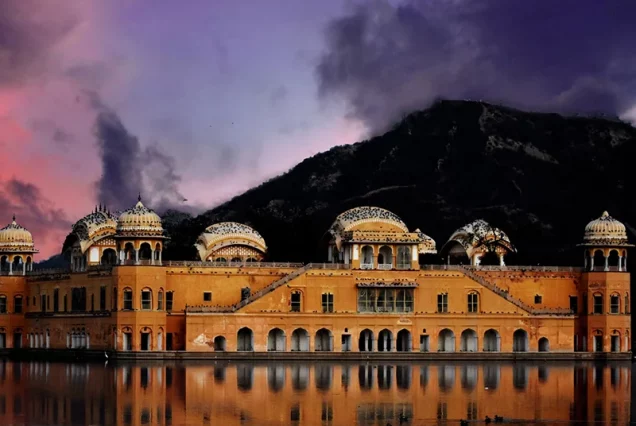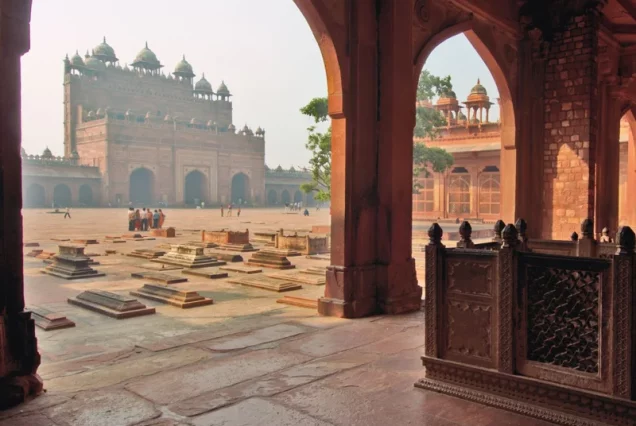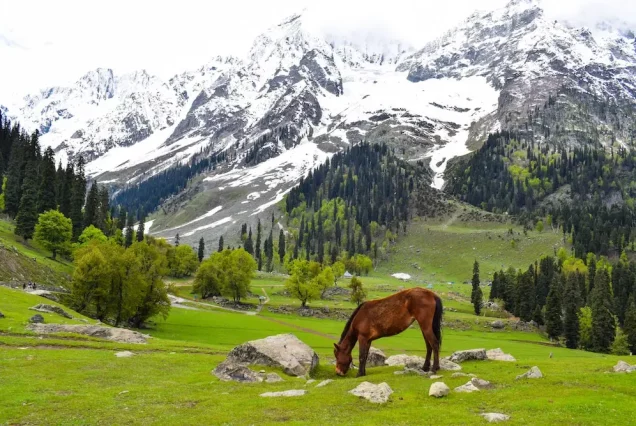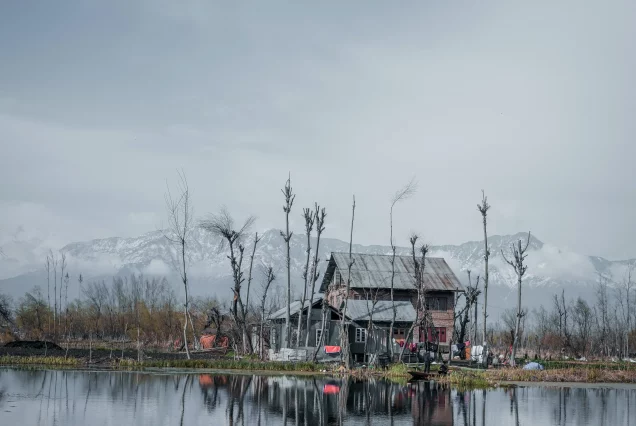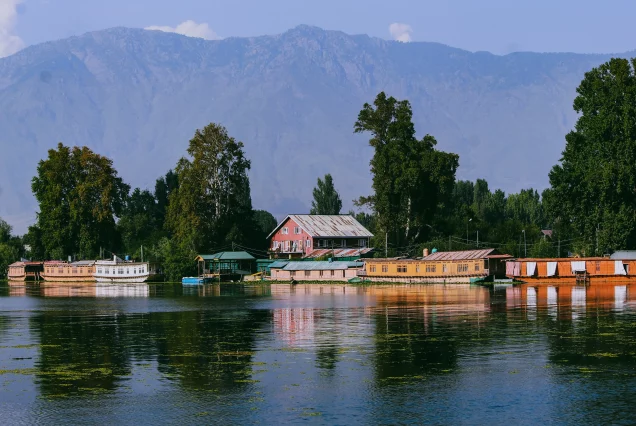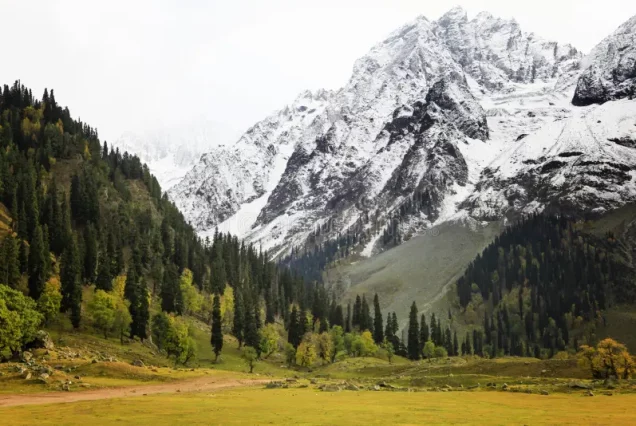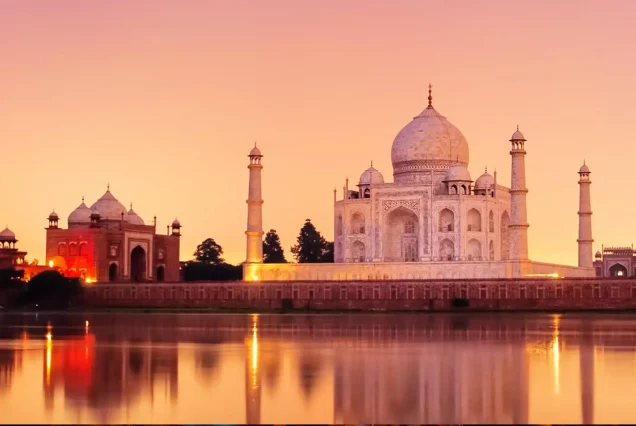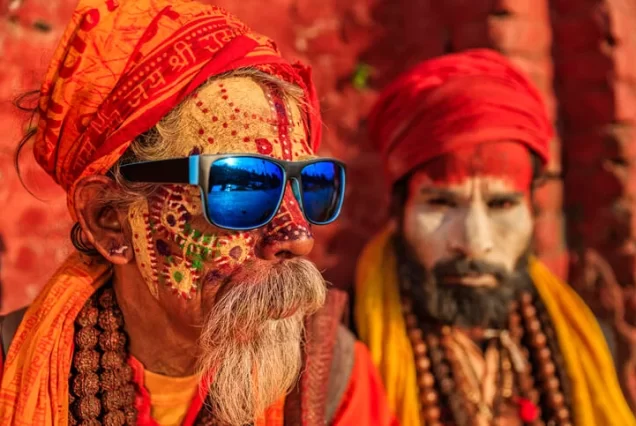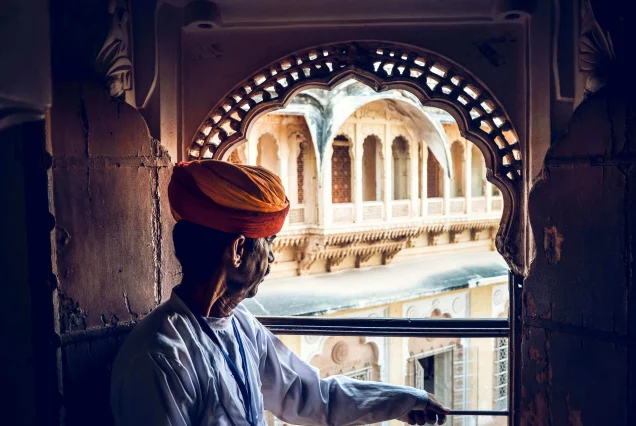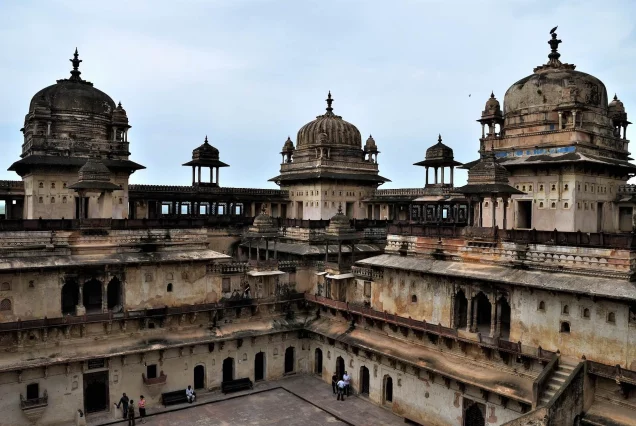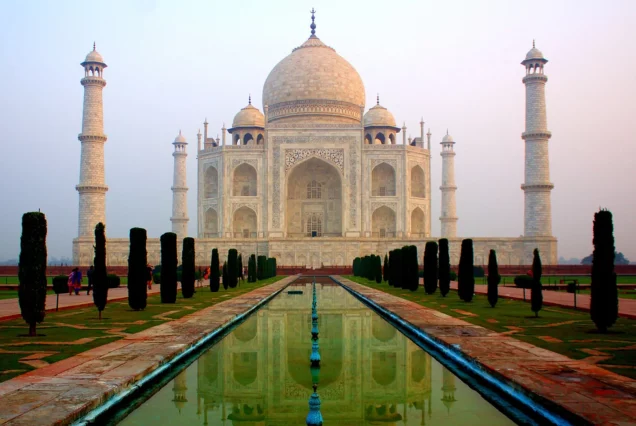Golden Triangle with Kashmir
Jammu and Kashmir is the 19th largest state in India which is located on the Himalayan mountains. Jammu and Kashmir is one of the most famous tourist destinations in India which offers majestic mountains, beautiful valleys and religious shrines. Custom Tours India is here to take you around the history and valour of great Rajputana and Mughal Empires along with the beauty of Himalayan Mountains.
Kashmir is a bag full of natural beauty which has many lakes, beautifully laid gardens and hill stations which attracts thousands of tourists all over the year. Also known as “Switzerland of India” and “Paradise on Earth ”, Kashmir has a number of wildlife sanctuaries where one can see the diverse topography as well as rarest species of animals. Along with this, one can really enjoy and cherish the local traditions and culture of this place by witnessing their local dance forms, music, festivals and cuisines. Kashmir is well-known for their local handicrafts like carpets, shawls, rugs, walnut wood furniture and dry fruits which are exported world-wide.
Custom Tours India is here to take you on a fully customized private tour in India with the world-famous tourist circuit which is “Golden Triangle of India” that covers three major cities of India – Delhi, Agra and Jaipur. If you are planning to visit India for the first time, you must go for this circuit which is the perfect example and picture of ancient history, varied culture and valour of Rajputana and Mughal Empire in India. This circuit covers the major tourist destinations in India which are different from any other tourist places in the world.
Golden Triangle Tour Itinerary with Kashmir
| Day | Place | Summary |
|---|---|---|
| 1 | Delhi | Arrival |
| 2 | Delhi | Jama Masjid, Chandni Chowk, Humayun’s Tomb, Raj Ghat, Qutub Minar |
| 3 | Delhi - Agra | Check-in At The Hotel |
| 4 | Agra | Taj Mahal, Agra Fort, Itmad-Ud-Daulah, Mehtab Bagh |
| 5 | Agra - Jaipur | Fatehpur Sikri |
| 6 | Jaipur | Hawa Mahal, Jal Mahal, Amber Fort, City Palace, Jantar Mantar |
| 7 | Jaipur | Jaigarh Fort, Nahargarh Fort, GaltaJi Temple |
| 8 | Jaipur - Kashmir | Stay at Dal Lake Houseboats |
| 9 | Kashmir - Pahalgam | Betaab Valley, Aru Valley |
| 10 | Pahalgam - Gulmarg | Skiing, Gondola Ride |
| 11 | Gulmarg - Srinagar | Pony Rides, Romantic Walks, Bird-watching, Playing Golf |
| 12 | Srinagar | Mughal Gardens, Shalimar Bagh, Nishat Bagh |
| 13 | Srinagar - Delhi | Departure |
Day 1: Arrival at IGI Airport, Delhi
Upon arrival, a representative from Custom Tours India will meet you and will escort you towards your air-conditioned car and drive will remain at your disposal for the complete time in India. On the way to your hotel, our representative will tell you short stories about the places you will be visiting. Later, check-in at the hotel.
Day 2: Local Sightseeing in Delhi
This morning, Custom Tours India will arrange a full day guided tour of Delhi with aEnglish-Speaking Guide who will remain with you for the complete day explaining the history and importance of each monument you will be visiting.
- Jama Masjid – Jama Masjid is one of the largest mosques in India which is situated in Old Delhi. After the death of Shah Jahan’s wife, the emperor shifted his capital from Agra to Delhi and laid the construction work of this mosque in 1644. The mosque is built using red sandstone and marble. The mosque is built at an elevation of 10m which can accommodate 25,000 devotees at one time. As the mosque is situated inside the old city you can get a splendid view of the bustling bazaars and the narrow streets of ChandiChawk.
Following this monument, you will be taken for a short and adventurous Rickshaw Ride in Old Delhi covering narrow streets of ChandiChawk where you can see the glimpse of daily life.
Later, we will head for lunch at one of the famous restaurants in the city.
- Humayun’s Tomb – Humayun’s Tomb is the first garden tomb in India which is build using red sandstone and the main tomb in built using white and black marble which makes it worth visiting. This historical monument of India narrates the saga of love and longing as this monument was built by Humayun’s first wife – Haji Began in the loving memory of her husband. The monument consists of a huge lawn which is divided into 4 sections where you can see beautifully laid gardens, flower beds, fountains and water channels. Further, these 4 sections are divided into 36 sub-parts which makes this monument a great spot of photographs.
- Raj Ghat and Gandhi Memorial – Raj Ghat is built in the memory of Mohandas Karamchand Gandhi, also known as “Father of the Nation”. This memorial is situated on the banks of Yamuna River due to which you can see lush green gardens and lawns. Raj Ghat being the place where Gandhiji was cremated and took his last breath, this memorial is one of the important memorials in India. You can see the last words of Gandhiji “HE RAM” written on the black marble on the main memorial. You can also witness the two museums built nearby in the loving memory of Gandhiji.
- Qutub Minar – Qutub Minar is the world’s tallest brick minaret which stands at a height of 73 feet from the ground. This historical monument in India is one of the oldest structures built in the history of Delhi which was commissioned by Qutub-Ud-Din-Aibak in 1192 AD. However, due to the sudden death, the monument was later completed by his successors. This minaret has 5 storeys in which the first three storeys are built using red sandstone and the remaining two storeys are built using marble and sandstone. One of the major attractions of this monument is the Iron Pillar which was laid by Ashoka the great of the Mauryan Empire dated 4th century.
Later, the rest of the day is free at leisure. If you wish to go outside for dinner you may ask your driver to wait at the hotel.
Day 3: Drive to Agra
This morning, check-out from the hotel and then drive to the second city of Golden Triangle Tour Package is Agra which is renowned for its one of the seven wonders of the world – Taj Mahal. Upon arrival, check-in at the hotel and the rest of the day is free at leisure. If you wish to go out for dinner, you may ask your driver to wait at the hotel.
Day 4: Local Sightseeing in Agra
This morning, we will be starting early as this is the best time to visit “Taj Mahal”. Here, Custom Tours India will arrange a full day guided tour of Agra where your English-speaking tour guide will tell you each and every story about the monuments present in Agra.
- Taj Mahal – One of the seven wonders of the world – Taj Mahal is located on the banks of Yamuna River which was built by Mughal emperor Shah Jahan in the loving memory of his favourite and third wife – Mumtaj Mahal. This marvellous monument was built using white marble in the year 1648 which currently houses the tomb of both Shah Jahan and Mumtab Mahal. The name of this monument is derived from Persian language which means Taj as “Crown” and Mahal as “Palace”. It took almost 22 Years and 20,000 workers to build this beautiful monument.
Later, we will head back to your hotel where you can relax for a while and go for breakfast. Following which, we will start the city tour again around 11:30 am.
- Agra Fort – Agra Fort or Red Fort was built by Mughal Emperor Akbar in the year 1565 however, the construction was fully completed by his grandson Mughal Emperor Shah Jahan. This massive fort is one of the best forts in India which is located on the right bank of Yamuna River which used to be the residence of Mughals family until 1638 when the capital moved to Delhi. This historical monument of India is built entirely on red sandstone which is the perfect example of Mughal art and architecture. You can also witness some of the white marble monuments which were added by Shah Jahan.
- Itmad-Ud-Daulah – This beautiful white marble tomb was built by Mughal Empress Nur Jahan, wife of Mughal Emperor Jehangir in the loving memory of her father Mirza Ghias Beg who was a minister in the Mughal Court. The monument was built between 1622 and 1628 using pure white marble and semi-precious stone using Persian and Mughal architecture. Local people say that the idea of Taj Mahal was taken from this monument hence, this monument is also known as “Baby Taj”. Outside the main tomb, you can see beautifully laid gardens, water channels and flower beds. This is the first tomb which is built on the banks of a river.
Mehtab Bagh – Mehtab Bag is believed to be the last and 11th pleasure gardens which were built on the banks of a river by Mughal Emperor Babur. Mehtab Bagh is the perfect spot to take pictures of the Taj Mahal from the back side as this garden is located on the opposite side of the river. Here, you can also witness the traces of another monument which Shah Jahan was planning to build that would look like the Taj Mahal using the black marble. This garden is spread over 300 sq. M which has perfectly laid pavilions, lawns, flower beds, fountains and water channels.
Day 5: Drive to Jaipur. En-route visit Fatehpur Sikri
This morning, have your leisurely breakfast and then we will start towards Jaipur which is the third main city of Golden triangle tour package and one of the most beautiful cities in India – Also, known as “Pink City” because of the outer walls of the old city painted in the shade of Pink. On the way to Jaipur, we will take a short break at Fatehpur Sikri which was the home of Mughal Emperor Akbar for 20 Years before the capital shifted to Agra.
- Fatehpur Sikri – Situated at a distance of 40 kms from Agra, this fortified city is made of red sandstone which was founded and built by Mughal Emperor Akbar in the year 1572. Before building the palace, Akbar visited this place in search of a Sufi saint – Salim Chisti who blessed the king with a son. After the wish came true, Akbar built a beautiful palace for his favourite three wives and a mosque dedicated to the Sufi saint. Later, Fatehpur Sikri served as a Mughal capital for the next fifteen years. The main attractions of this place are the Jodha Bai’s Palace, Jama Mosque, BulandDarwaza and the tomb of Sufi saint. This magnificent palace is built using Arabian, Mughal and Persian architecture.
Upon arrival in Jaipur, check-in at the hotel and the rest of the day is free at leisure.
Day 6 - Local Sightseeing in Jaipur
This morning, have your breakfast and then a government certified tour guide will escort you for a full day guided tour of Jaipur who will tell you short stories and history of each monument you will be visiting.
- Hawa Mahal – Hawa Mahal or “Palace of Winds” was built in the year 1799 by Sawai Pratap Singh. This palace was built for the royal women where they used to sit to see the daily life of local people and the bazaars. This building consists of 953 small windows with lattice work which helps the royal ladies to sit freely and see down, however, blocking the view from outside so that local people could not see inside the windows. The best place to click some extremely beautiful pictures of this palace is from one of the cafe’s setups at the front side of the palace.
- Jal Mahal – Another beautiful 5 storey palace which is located in the middle of the Lake Man Sagar built in the year 1745. This palace was considered a summer palace for the king to spend some leisure time with his queens. The 3 storeys are under the water however, the upper two remain outside the water which has approx. 65 suite rooms and a luxury open garden on the top floor. As this is a private palace, you can stop by the road to take some pictures. A stop of 10 minutes would be enough.
- Amber Fort – Amber Fort is one of the most visited forts in India and one of the three forts which were built in and around Amber – the old capital. Amber Fort is built with the mixture of Hindu and Mughal architecture whose construction was started in the year 1592 by Raja Man Singh I. This fort was built for pleasure purposes by the royal family using precious stones, mirror work and miniature paintings on the walls. Inside the fort, the two main attractions are the – Ganesh Pol, one of the 9 gates in Jaipur. This gate is famous for the art works done with the help of exquisite colours and gold leafs. The second most attractive attraction is the mirror palace built in the main complex of the fort. You will love to see the strong pillars, gardens and wall swings where the king used to meet local and special persons of his court.
Later, you will be taken for lunch at one of the famous restaurants inside the old pink city.
- City Palace – The city palace was built in the middle of the new city when the king, Jai Singh II declared Jaipur as the new capital. The palace was built in the year 1732 which is used to be the seat and home of Maharaja of Jaipur. This palace is built in a mixture of rajput, Mughal and European style making it one of a kind. The main attraction of this palace are the different gates designed in one of the courtyards which showcase the different themes and shades of Rajput’s culture and traditions. You can explore the royal museum inside the palace where you can have a look at ancient royal costumes, exquisite pashmina shawls, famous sanganeri printed fabrics, weaponry, maps and pictures of the royal family.
- Jantar Mantar – Jantar Mantar is a UNESCO World heritage site situated adjoining to the City Palace which was constructed by Jai Singh II that holds the record of world’s biggest sundial. You will be amazed to see the observatories, instruments built using stones and brass to calculate time and to check astronomical positions with your naked eyes.
Rest of the evening is free for leisure. Jaipur is also famous for its handicrafts, textile, blue stone pottery, carpets, precious and semi-precious stones. Here, if you wish to explore you may ask the driver to take you to one of the markets.
Day 7: More Local Sightseeing in Jaipur
This morning, you can have a leisurely breakfast at your hotel and then head towards the remaining sightseeing places of the city. Today you can visit monuments on your own and if you wish to have a tour guide, we will arrange for today as well. You will be taken to visit the below sights.
- Jaigarh Fort – The second fort amongst the three, Jai Garh fort is located 400 m above the Amber Fort which acts as a military fort and was designed to protect Amber Fort from the enemies. This fort was built by Jai Singh II in the year 1726 which has a hidden tunnel connecting Jaigarh to Amber Fort. You will love to see the cannon foundry here which has built the world’s largest cannon known as “Jaivan Top”. This cannon was shot only once for the testing purpose. The canon ball which was used for testing purposes weighed 50 kg and got hit at a distance of 35 kms from the place of fire. The fort has beautifully laid gardens and watch towers which provides 360-degree view of the city and the Aravalli Hills.
- Nahargarh Fort – Third fort of the city which was built in the year 1734 by Sawai Jai Singh II. This fort was a summer palace used by the king for pleasure and relaxing. This fort was never attacked because the king had powerful allies with Mughals. The fort consists of several courtyards in which the most beautiful is Madhavendra Bhawan which has amazing suites for different queens and a hallway which connects all the suites. The king used this hallway to visit any queen of his choice without letting the other know. The open terrace provides a wonderful view of the city and the Aravalli Hills.
Later, at noon, we will take you to one of the famous restaurants of the city where you can have your lunch.
- GaltaJi Temple – One of the most attractive temples in Jaipur, Galtaji Temple is located on the outskirts and in the foot of Aravalli Hills which is dedicated to Lord Ram, Lord Krishna and Lord Hanuman. This temple is built using pink-colored sandstone and consists of various shrines, holy kinds, pavilions and natural springs. The remarkable building is decorated with painted walls, round roofs and pillars. This temple is well-known for one of the kinds named “Galta Kund” which is the holiest one and is believed never to get dry. This temple is also known for the many tribes of Monkeys that are found here and the religious hymns and chants.
Later, you will be transferred back to your hotel.
Day 8: Fly to Kashmir
Early morning, have your breakfast and then check-out from the hotel. Later, you will be transferred to Jaipur International Airport from where you will fly to Srinagar (Kashmir). Upon arrival, our representative will meet and escort you to your car and driver. On the way to your hotel, you can enjoy the scenic views and the local markets of the city.
Today you will be staying at one of the luxury and premium houseboats where you can enjoy the scenic and beauty of Dal Lake and have the wonderful experience of staying overnight in these beautiful houseboats.
Later, in the evening, you will be taken for a short ride in Kashmir’s famous Shikhara – A wooden boat, which will take you around the lake. While on the boat, you can experience various floating markets, shopkeepers running towards your boat to sell Kashmiri Kahwa’s (Chai), dry fruits and other local cuisines. Kashmir is well-known for its shawls which are made specially from Pashmina – a type of cashmere wool which is extremely soft and fine.
Day 9: Drive to Pahalgam
This morning, have your leisurely breakfast and then we will start the day driving towards our next destination which is Pahalgam. The drive from Srinagar to Pahalgam is itself a gem when you pass through the saffron fields, rice fields and the authentic countryside of Kashmir.
Pahalgam is well-known as “The valley of Shepherds” and “Paradise for Trekkers” as we have numerous treks which start from Pahalgam and nearby villages. The drive to Pahalgam will be for approx 3.5 hours from Srinagar. On the way to Pahalgam, you will be taken to visit one of the oldest temples in India which is dedicated to Lord Vishnu and is almost 1100 years old.
Upon reaching, check-in your hotel booked by Custom Tours India and then have your lunch. Post lunch, you can opt to explore the nearby beautiful valleys and sites on your own as outside vehicles are not allowed in these places.
- Betaab Valley – Betaab valley is one of the popular tourist destinations near Pahalgam which is located at a distance of 15 kms. Originally known as “Hagan Valley” however, it is known as Betaab Valley as one of the famous Bollywood movies was shot here. The surrounding makes this place really mesmerizing with the lush green meadows, mountains, dense vegetation and huge trees such as Chinar, Deodar and Pine. This is a perfect place for picnic and sightseeing. You may spot a leopard or brown bear which are there in the forest.
- Aru Valley –Aru Valley is situated at a distance of 12 kms from Pahalgam in a small village which is surrounded by lush green pine trees, meadows and snow-covered Himalayan mountains. The picturesque views of this valley make it worth visiting and attract tourists from all around the world. The views here are extremely beautiful and the river flowing through the valley adds more glitter to this place. This valley is the starting point for many treks in which the popular treks are TarsarKarsar Trek and Kolahoi Glacier Trek.
Later, in the evening return back to your booked hotel and spend your lovely evening in your beautiful hotel with the amazing view of the surroundings.
Day 10: Drive to Gulmarg and Local Sightseeing
This morning, have your breakfast and then check-out from the hotel. Later, we will proceed our drive towards our next destination which is Gulmarg. Gulmarg is situated at a distance of 140 kms from Pahalgam and this four-hour drive through the colourful villages and rice fields provides you a perfect insight about the rich cultural heritage of India and Kashmir.
Gulmarg is one of the popular hill stations in India Which is well-known all around the world by the name of “Meadows of Flowers”. Gulmarg is believed to be “Heaven on Earth” and a place where even Gods come to visit to cherish this beautiful place on Earth.
The main attractions and activities of this place are skiing and taking a short ride of the famous Gondola Ride.
Rest of the evening is free for leisure. You may spend the lovely evening at your hotel or choose to explore the nearby places on your own by foot.
Day 11: Sightseeing and Drive to Srinagar
Have your leisurely breakfast and then go for a short sightseeing tour of the city visiting the main attractions of this Hill station in India.
- Gondola Ride – Gondola Cable car ride will be of 8 minutes one sided which will take you to one of the peaks of Gulmarg from where you can take plenty of pictures of snow-covered Himalayan mountains, lakes and colourful shepherd huts.
Later, you may choose to go for some fun activities like short pony rides, romantic walks, bird-watching or playing golf in the World’s highest golf course.
Later, check-out from the hotel and start your drive back to Srinagar. Enjoy a short drive of around 2-3 hours through the unexplored villages of Kashmir and experience their daily life and culture of this beautiful state of India.
Upon arrival, check-in at your hotel booked by Custom Tours India and spend your rest of the evening relaxing by the pool or in your cosy room.
Day 12: Local ightseeing in Srinagar
This morning, have your breakfast and then we will head towards the famous tourist destinations of Srinagar and nearby places. We will take you to visit some of the famous sightseeing places in Srinagar.
- Mughal Gardens – Srinagar is home to some of the most unique and beautiful gardens built by Mughals in India. These Mughal gardens in India are commonly influenced by Persian and Mughal architecture which attract tourists from all over the world. These gardens have a variety of trees, flower beds, water channels, wild grass and the bird which makes these gardens worth visiting. These Mughal gardens in India have their unique system of water cannels and pools which reflects the clear blue colour of the sky and the mountain ranges surrounded by this place.
- Shalimar Bagh – Shalimar Bagh is another one of the most visited Mughal Gardens in India Which was built in 1619 by Mughal Emperor Jahangir for his wife Nur Jahan. This is the largest Mughal Garden in India which is also known as “Abode of love” located on the banks of Dal Lake. The best time to visit this garden is during Autumn and Spring.
- Nishat Bagh – Nishat Bagh is located very close to the Shalimar Bagh and is one of the most beautiful Mughal gardens in India situated on the banks of Dal Lake. The garden is well-known as “The garden of pleasure” locally as it provides a mesmerizing view of the Pir Panjal Mountain range and nearby surroundings.
These are the few famous Mughal gardens in Kashmir which are must and attract tourists from all over the world. Rest of the day is free at leisure.
Day 13: Fly to Delhi and then back to your Hometown
This morning, pack your bags and lovely memories of this amazing Golden Triangle tour with Kashmir and drive to the Airport to fly back to your hometown. Custom Tours India would love to have you back with us for another yet amazing tour of India.
My unique tour
When you search "Golden Triangle tours" in the internet you get tons of sites offering you this opportunity. But CustomTours is quite different. They are *custom*. It's my second trip this route. But it is not the same route.
Gvaduha
Ride with Nand
This amazing trip started in the early morning at the Delhi airport, where our driver, Nand Singh, met us. The next 4 days we spent with him doing one of the best trips of my life. He drove us to many great places, and we enjoyed the trip very much.
Vadim
Another wonderful trip!
This was my third trip booked through Sonia and her team. I was travelling with my parents and an aunt, all of whom are in their 80's. Our plans were a little complicated as we were all coming from different locations to meet in India for a two-week tour of Kerala.

ASL345
Classic Rajasthan Private Tour
We wanted to do more than the Golden Triangle.Ranthambore (tigers), Jaisalmer and Udaipur were a must. Sonia booked all this and more besides in super hotels and havelis, with an excellent driver for the whole trip and very knowledgeable tour guides in every city.
Bluenose10
Look no father for an excellent tour company
If you are looking for a special trip to India and its beautiful varied regions, Custom Tours India is the company to contact and have plan the trip. I have been to India 5 times (all planned by CTI and Sonia) and each time,
SavannahAnnie
India my favorite country
I have been to India several times always using Custom Tours India, Sonia is a delight to work with she may not say the same for me. I travel a lot, I can say Sonia is on top of every detail which makes the trip run so smooth.
Nancy Ruby
Outstanding
This was my 4th trip to India with Custom Tours. I cannot say enough positive things about Sonia and her drivers. They go way beyond to make sure every aspect of your trip is wonderful! They treat you like family.
Stephanie C
wonderful
I worked with Sonia to arrange our trip to India. She made it a very easy experience for us, made recommendations and answered all our questions. Our hotel stays were excellent. She even booked our air tickets
Melinda W
North India Trip
We worked with Sonia at Custom Tours India during our recent trip to India. She made it a very pleasant experience for us. She booked us at great hotels (Oberoi and Taj) at reasonable price. Our hotel stays were excellent.
Shankar N
Tour Map
Reviews
There are no reviews yet.
Quick Links
Contact Info
- 1-A, Fateh Nagar, Surya Nagar, Taroon ki Koot, Tonk Road, Jaipur (Rajasthan) – 302015
- Copyright © 2023 | Custom Tours India | All rights reserved



